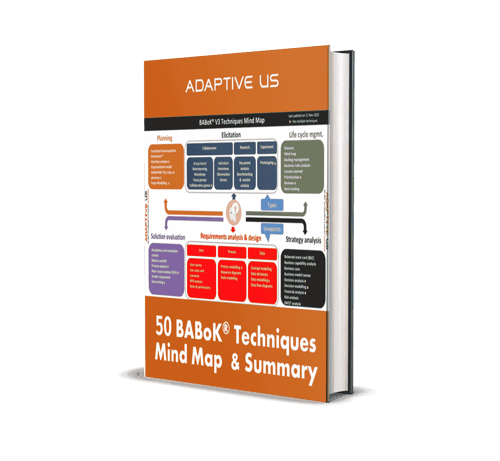Are you a product owner or business analyst looking to level up your game? Well, you're in luck! In this blog post, we'll dive deep into the top 10 techniques used by successful product owners. These tried and true methods will help streamline your workflow, boost productivity, and ultimately create exceptional products that exceed customer expectations.
By leveraging these tools and techniques, you can effectively manage your product backlog, create minimal viable products (MVPs), develop user personas, map out product roadmaps, estimate project timelines accurately, and conduct insightful meetings, retrospectives, and reviews.
So buckle up and prepare for an informative journey where we break down each technique's definition and overview its strengths and limitations. Whether you're new to the role or a seasoned pro looking for fresh insights, this article covers you. Let's dive right in!
How can using tools and techniques help a product owner's workflow?
As a product owner, your role is multifaceted and demands efficient handling of various tasks. This is where using tools and techniques becomes invaluable in enhancing your workflow. These tools provide structure, clarity, and organization to the complex process of developing and managing products.
You can effectively prioritize and manage your product backlog by leveraging these tools. With techniques like backlog refinement, you can continuously groom your backlog by adding new items, removing irrelevant ones, or reordering based on changing priorities. This ensures that you always clearly understand what needs to be done next.
Another powerful technique is the use of minimal viable products (MVPs). Creating MVPs early in the development cycle allows you to gather valuable feedback from users and stakeholders. This iterative approach allows for quick validation of ideas while minimizing wasted efforts on features that may not resonate with customers.
Personas are another tool that helps product owners better understand their target audience. Personas provide insights into user preferences, motivations, and pain points by creating fictional representations of typical users. Product owners can make informed decisions during feature prioritization or design discussions with this knowledge.
Product roadmaps offer a strategic overview of how the product will evolve. They help align teams around common goals by providing visibility into upcoming features or enhancements. Product owners can leverage roadmaps to communicate plans to stakeholders while keeping everyone focused on delivering value.
Relative estimation provides a way to estimate work effort without getting bogged down by specific numbers or hours spent per task. It allows teams to compare relative sizes or complexities through story points or t-shirt sizing. This technique enables better planning and resource allocation without getting caught up in unnecessary details.
Effective meeting retrospectives ensure continuous improvement within the team's processes by reflecting on what went well and areas for improvement after each sprint or project milestone.
Reviews play an essential role in validating progress against business objectives and gathering feedback from key stakeholders at different stages of product development.
1. Product Backlog Refinement - Definition, overview, strengths and limitations
As a product owner in the ever-evolving business landscape, it is crucial to have effective techniques that streamline your workflow. One such technique is Product Backlog Refinement.
Product Backlog Refinement refers to the ongoing process of reviewing and prioritizing items in the product backlog. It involves collaborating with stakeholders and cross-functional teams to ensure the backlog remains relevant and aligned with business goals.
The strength of Product Backlog Refinement lies in its ability to provide clarity and transparency. By regularly refining the backlog, you can identify dependencies, remove outdated or redundant items, and ensure that high-priority features are given attention.
However, like any technique, Product Backlog Refinement has its limitations. It requires active participation from all stakeholders to be effective. In some cases, conflicting priorities may arise during refinement sessions, slowing progress or leading to compromise.
Despite these limitations, Product Backlog Refinement remains an essential tool for product owners as it helps maintain focus on delivering value-driven products. By continuously evaluating and adjusting the backlog based on feedback and changing market dynamics,
You can stay ahead of customer demands while maximizing return on investment.
In conclusion, Business Analysts play a vital role in shaping successful products by utilizing various techniques such as Product Backlog Refinement.
The key takeaway here is that by understanding these techniques thoroughly and leveraging their strengths while being aware of their limitations, you can enhance your role as a product owner, enabling you to deliver exceptional value through your products
2. Minimal Viable Product (MVP) - Definition, overview, strengths and limitations
The concept of a Minimal Viable Product (MVP) is widely used in product development. An MVP is the most essential product version that still provides users value. Product owners can test their ideas and gather feedback before investing significant time and resources into building a fully-featured product.
The main goal of an MVP is to validate assumptions and learn from user interactions quickly. By releasing a stripped-down product version, it becomes easier to identify what works and what needs improvement. This iterative approach enables product owners to make informed decisions based on real-world data.
One major strength of using an MVP is its ability to save time and money. Instead of spending months or even years developing a complex solution, you can launch with just the core features necessary for users to achieve their goals. This not only reduces development costs but also accelerates time-to-market.
Moreover, an MVP allows for early customer engagement, which leads us directly to another strength: gathering valuable user feedback. By putting your minimal viable product in front of customers as soon as possible, you can collect insights about their needs, preferences, and pain points. Armed with this information, you can refine your product strategy and make improvements that align more closely with user expectations.
However, there are limitations associated with using an MVP approach, too. One potential challenge lies in striking the right balance between simplicity and functionality – finding that sweet spot where your minimal viable product offers enough value without being overly complex or confusing for users.
Launching an MVP requires careful planning and prioritization since not all features will be included initially. It's essential to define clear criteria for determining which functionalities are crucial at each stage of development.
The MVP technique empowers product owners by providing them with actionable insights early in development while minimizing risks associated with building extensive products without validated demand or market fit.
3. Personas- Definition, overview, strengths and limitations
Personas play a crucial role in the product development for a Product Owner or Business Analyst. But what exactly are personas? In simple terms, personas are fictional characters created to represent different user types within a targeted audience.
These personas help the product owner better understand their customers' needs, goals, behaviors, and pain points. By creating these profiles, they can make informed decisions on designing and prioritizing features that will best meet the users' requirements.
The strengths of using user personas are numerous. They provide empathy and create a shared understanding among the team members about who their customers are. This helps align everyone's efforts toward developing solutions that resonate with the target audience.
Personas enable prioritization by allowing the product owner to determine which features or enhancements will significantly impact each persona group. This ensures that resources are allocated effectively and efficiently.
However, there are also limitations when it comes to using personas. It's important to remember that they're based on assumptions and generalizations rather than actual data from real users. Therefore, there is always a risk of bias creeping into persona creation.
Additionally, as market conditions change or new segments emerge within the target audience, existing personas may become outdated or irrelevant. Regular updates and validation through user research should be conducted to keep them accurate and useful.
In conclusion, while there may be some limitations in utilizing personas as part of your product development process as a Product Owner or Business Analyst, their benefits far outweigh any potential drawbacks./any disadvantages/ They provide valuable insights into customer needs, aid decision-making, and facilitate effective team communication. By leveraging this technique effectively, product owners can deliver tailored products for their users, driving business success./achieving desired outcomes/.
4. Product Roadmap - Definition, overview, strengths and limitations
The product roadmap is a strategic tool that helps product owners plan and communicate the direction of their products over time. It outlines the key features, functionalities, and deliverables that will be developed and released to meet customer needs.
Overview
A product roadmap visually represents the product's evolution, serving as a high-level guide for stakeholders to understand what will be built and when. It aligns business goals with development efforts, ensuring everyone is on the same page.
Strengths
One of the main strengths of a product roadmap is its ability to prioritize features based on customer feedback or market trends. This allows for agile decision-making and adaptability in response to changing circumstances. Additionally, it serves as an effective communication tool between different teams involved in the development process.
Limitations
However, it's important to note that creating an accurate roadmap can be challenging due to uncertainties in technology advancements or market conditions. The future is uncertain; therefore, plans may need adjustment. Another limitation is that too much detail can stifle innovation by restricting flexibility.
In conclusion,
Using a well-defined product roadmap can significantly benefit businesses and analysts alike. By providing clarity around priorities and timelines while allowing for flexibility when needed, this tool enables efficient planning and collaboration throughout the entire lifecycle of a product.
5. Relative Estimation: Definition, Overview, Strengths, and Limitations
One technique that product owners often rely on is relative estimation. This method involves comparing the size or complexity of different tasks or user stories to determine their relative effort. Rather than assigning specific time estimates, product owners use a scale such as Fibonacci numbers (1, 2, 3, 5) or t-shirt sizes (XS, S, M, L) to rate the level of effort required.
Product owners can prioritize tasks based on their perceived complexity using relative estimation techniques and allocate resources accordingly. This approach allows for flexibility and adaptability within the development process.
However, it's important to note that relative estimation has its limitations. The accuracy of these estimates heavily relies on the team's understanding and familiarity with the project requirements. Different team members may interpret complexity levels differently, leading to inconsistent estimations.
Despite its limitations, several strengths are associated with using relative estimation in agile development environments. One strength is that it promotes collaboration among team members by encouraging discussions and sharing insights about task complexities. Additionally, this technique helps manage stakeholder expectations by providing a more realistic depiction of project timelines.
In conclusion,
Relative estimation is a valuable tool for product owners in managing projects efficiently within an agile framework. While it may not be perfect due to subjective interpretations and potential inconsistencies among team members' estimations, it offers benefits such as fostering collaboration and setting realistic stakeholder expectations.

6. Meeting Retrospective - Definition, overview, strengths and limitations
A meeting retrospective is a valuable technique owners use to reflect on past and improve future meetings. It provides an opportunity for the team to review what went well and identify areas for improvement.
During a meeting retrospective, the team gathers to discuss various aspects of the meeting, such as communication, collaboration, decision-making, and overall effectiveness. The goal is to identify patterns or issues that may have hindered productivity or caused misunderstandings.
One of the strengths of a meeting retrospective is its ability to foster open communication within the team. Creating a safe space for everyone to share their thoughts and opinions encourages active participation from all members. This can lead to better understanding among team members and improve collaboration in future meetings.
Another strength of this technique is its focus on continuous improvement. By regularly reflecting on past meetings, product owners can identify recurring issues or bottlenecks that need addressing. This allows them to implement changes or strategies to enhance efficiency and effectiveness in future meetings.
However, there are also some limitations associated with meeting retrospectives. One limitation is that it requires time and effort from all participants. Finding dedicated time for retrospectives can be challenging in busy work environments with limited time.
Additionally, another limitation lies in ensuring actionable outcomes from these discussions. Without proper follow-up actions or accountability measures based on the identified areas for improvement during retrospectives, they may become just another discussion without tangible results.
In conclusion,
Meeting retrospectives are powerful tools product owners use to evaluate past meetings' success factors while identifying areas for improvement through open communication channels amongst teams; however, they require a dedicated time commitment from participants and effective follow-up action plans.
7. Reviews - Definition, overview, strengths and limitations
Reviews play a crucial role in product development, allowing product owners to gather feedback and make improvements.
Definition: Reviews are structured evaluations of a product or feature that involve gathering input from stakeholders, users, or experts. These assessments help identify strengths and weaknesses and guide decision-making.
Overview: Reviews can take various forms, such as design reviews, code reviews, or user experience reviews. They provide an opportunity for different perspectives to be heard and considered. Product owners can ensure their products meet user requirements by soliciting feedback early on and throughout the development cycle.
Strengths: Reviews enable collaboration between team members by promoting open communication and idea sharing. They allow for continuous improvement by identifying issues before they become significant problems. Additionally, reviews foster a sense of ownership among team members as they contribute to shaping the final product.
Limitations: Conducting thorough reviews requires time and effort from all parties involved. Disagreements may arise during this process due to conflicting opinions or priorities. Balancing multiple viewpoints can be challenging for the product owner when making decisions based on review feedback.
In conclusion,
Reviews are essential in a product owner's arsenal for gathering valuable insights into their products' performance and usability. While they have limitations like any other technique, leveraging well-executed reviews can lead to more robust solutions that align with business objectives while delivering value to end-users.
8. Story Decomposition - Definition, overview, strengths and limitations
Story Decomposition is a technique used by Product Owners to break down large user stories into smaller, more manageable tasks. It involves breaking the story into its constituent parts and prioritizing them based on their importance and complexity.
The process begins with identifying the main goal or objective of the user story. This helps us understand what needs to be achieved and how it can be broken down effectively. Once this is done, the next step is identifying any dependencies or prerequisites for completing each task.
One of the strengths of Story Decomposition is that it allows for better estimating the time and effort required for each task. Breaking down the more extensive user story into smaller pieces makes assigning resources and tracking progress easier. It also enables team members to work on different parts simultaneously, increasing efficiency.
However, one limitation of Story Decomposition is that it can be challenging to predict all dependencies upfront accurately. Sometimes, new dependencies may arise during development, leading to delays or rework. Another challenge is ensuring that all tasks are properly aligned with the overall vision and goals of the product.
Story Decomposition is a valuable technique in a Product Owner's toolkit as it allows for effective planning and execution of user stories. It helps in managing complexity while enabling better estimation and resource allocation. However, careful consideration must be given to identify all dependencies early on, and alignment with product vision remains intact throughout development.
9. Story Mapping - Definition, Overview, Strengths and Limitations
Story mapping is a powerful technique product owners use to visualize the user journey and prioritize features. It allows teams to represent their product backlog in a hierarchical structure visually.
In story mapping, user stories are organized from left to right based on their priority and complexity. The top row represents high-level epics or themes, while the subsequent rows break down these epics into smaller user stories.
One of the strengths of story mapping is its ability to provide a holistic view of the product's functionality. By visually representing the user flow and organizing it hierarchically, teams can easily identify dependencies between different features.
Another strength of story mapping is that it encourages collaboration among team members. Everyone involved in the project can contribute their ideas during the process, resulting in better alignment and shared understanding.
However, there are also limitations when using story mapping as a technique. It may be unsuitable for all projects or teams with limited resources or tight timelines.
Maintaining an up-to-date story map also requires regular grooming sessions and continuous refinement as new information arises or priorities change.
Story mapping is an effective tool for product owners seeking clarity on feature prioritization and creating a shared understanding within cross-functional teams.
10. Visioning- Definition, overview, strengths and limitations
Visioning is a powerful technique product owners use to create a clear and compelling vision for their product. It involves envisioning the future state of the product and articulating it in a way that inspires and motivates stakeholders.
In essence, visioning helps the product owner define what success looks like for their product. Creating a shared understanding of the desired outcome aligns everyone involved toward a common goal.
The strength of visioning lies in its ability to provide direction and purpose. It allows the product owner to communicate their aspirations for the product, which can serve as a guiding light throughout the development process.
Another advantage of visioning is that it enables prioritization. With a clear vision, the product owner can make informed decisions about what features or functionalities are essential to achieving that vision.
However, there are limitations to using this technique as well. One potential challenge is ensuring the vision remains flexible enough to adapt to changing circumstances or market conditions. Overly rigid visions may hinder innovation or prevent necessary pivots.
Additionally, communicating and maintaining alignment around the vision can be challenging when working with large teams or distributed stakeholders. Ensuring everyone understands and buys into the shared aspiration requires ongoing effort and effective communication strategies.
Visioning is an essential tool for any successful Product Owner but must be implemented carefully considering its strengths as well as limitations on flexibility and communication challenges associated with larger teams
Conclusion
In this fast-paced and competitive business world, product owners play a crucial role in driving the success of a product. Utilizing various tools and techniques can effectively manage their workflow and ensure that the product meets the business's and its customers' needs.
You May Also Like
These Related Stories

Mastering Agile Product Ownership

Technical Skills for Product Owner: Path to Success


No Comments Yet
Let us know what you think